NEW: The Health Benefits of Cedar Nut Oil enriched with Cedar Resin
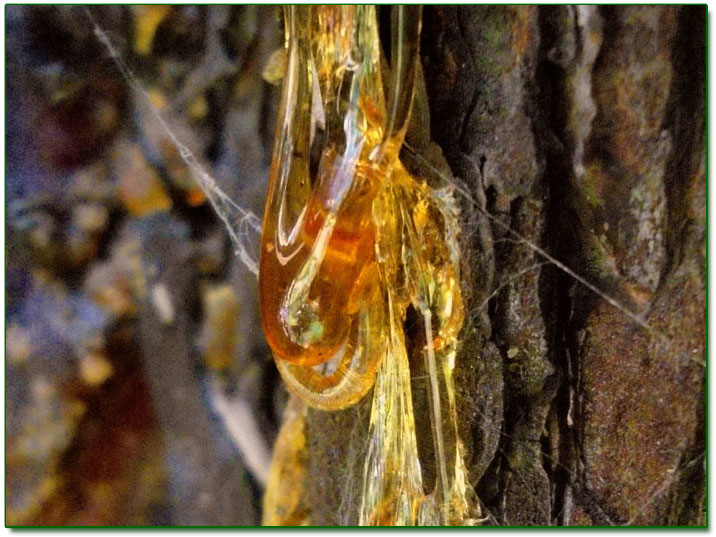
Siberian cedar nut oil enriched with cedar resin—this is an extract from the resin with cedar nut oil as a base.
During World War II, this extract was successfully used in military hospitals.
In military hospitals it made healing times shorter for wounded fighters, returned healthy warriors to the army, and kept many soldiers alive.
Tampons soaked with cedar extract stopped incipient gangrene and prevented wounds from festering and becoming infected.
Folk medicine has always used cedar resin in its centuries-old practice. Resin was poured on cuts and wounds. The most serious and chronic tissue injuries, including gangrene, were treated with cedar resin. It was applied to abscesses as a softening, extracting, and healing agent. In cases of fractures, the area of the injury was lubricated with resin—and the bone knitted more quickly. Resin was used in the treatment of purulent wounds, boils, and burns.
Unlike the resins of other coniferous species, Siberian cedar resin takes a long time to crystallize and does not lose its bactericidal qualities. Once upon a time in Siberia toothaches were treated with cedar resin by placing it on the tooth and gum.
The composition of cedar resin includes resin acids (77–77.5%)—abietic acid, lambertianic acid, dextropimaric acid, sapinic acid, and others—and higher fatty acids (0.3%), including lauric acid, palmitic acid, palmitoleic acid, oleic acid, stearic acid, and others.
In addition, cedar resin does not cause the irritation typical of the resins of other coniferous species.
THE HEALTH BENEFITS OF SIBERIAN PINE NUT OIL ENRICHED WITH PINE RESIN
The most striking historical example of this use of resin is embalming.
It is interesting to note that if the word “embalming” is translated verbatim into Russian, then it will mean “treating with resin,” literally wood resin with a strong fragrance. The result of embalming astounded not only our ancestors, but also amazes our contemporaries. Hundreds and thousands of years elapse, but bodies remain untouched by decay. An impression is formed that the body continues to live, while awaiting the return of its soul. This, of course, can be explained by the powerful antimicrobial properties of resin, but several thousand years ago, this seemed like a miracle!
In days of old, resin diluted with alcohol was used as a rub for aches. The smoke from burning resin possesses disinfecting properties. In some regions in the winter, peasants filled their huts with the smoke of burning resin in order to purify the air and remove a bad odor.
Cedar resin extract on a base of cedar nut oil (cedar nut oil enriched with resin) is a wonderful agent for stimulating and restoring metabolic processes and blood circulation in the brain. It improves the integral activities of the brain, especially in atherosclerosis, traumas, and other illnesses with obvious disruptions of cerebral blood circulation (disturbances of memory, attention, and speech, dizziness).
Cedar nut oil enriched with resin may be used in cases of depression and in gerontological practice, including the treatment of Alzheimer’s disease. Its use is advised in hypoxia of the brain caused by acute viral and mycoplasma infections, for example, the tick-borne encephalitis virus.
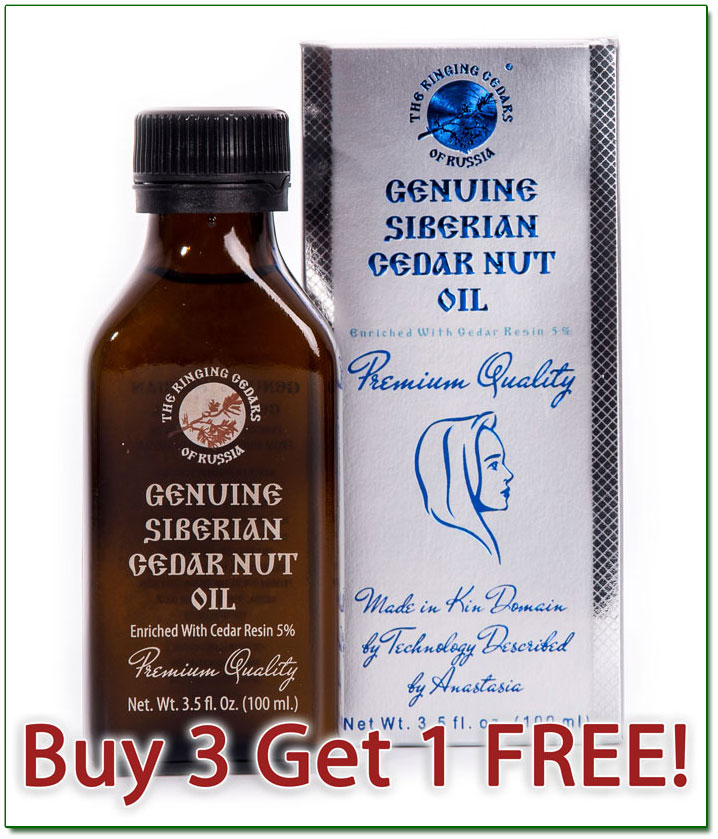
Cedar nut oil enriched with resin normalizes cardiac activity, including cases of myocardial infarction.
There is data about the prophylactic action of cedar nut oil enriched with resin in cases of tumor-related diseases: it increases the sensitivity of tumors to radiation and chemotherapy.
Cedar nut oil enriched with resin is able to protect the human body from smog, exhaust, gas and paint fumes, tobacco smoke, and other negative influences for up to four hours. For a person to have this four-hour protection, it is sufficient to take one teaspoon of the cedar extract.
Studies revealed for the first time that cedar nut oil enriched with resin possesses bioenergetic properties, thanks to which it is capable of improving the health of the body’s cells and bringing them to the level of “normal biological activity.”
For example, a person uses cedar nut oil enriched with resin for a month, during which time resinous substances accumulate in his or her body, and as soon as their level reaches an upper point, an “automatic switching” of the mechanism for self-regulated wellness occurs. The Siberian cedar extract easily finds its way into the human body through the saliva, blood, and pores of the skin.
One needs only to take cedar nut oil enriched with resin from time to time in order to maintain the resin balance in the body. Treatment and health improvement will occur on their own!
When persons begin to use cedar nut oil enriched with resin consistently, they improve their health and, at the cellular level, they pass on this “improvement” to their children. And if their children also use cedar extract regularly, then their health will be significantly better!
Victor E. Tarasenko, PhD,
for "Health and Wellness" magazine, 2017
* * *
Customer Reviews:
I am told that for those with intestinal disorders, when unhealthy bacteria has taken over to put a few drops of this product onto a sugar cube, swallow. The sugar acts as bait, the bacteria eats sugar and cedar oil, bacteria dies off. In many cases this is one of few treatments that really works.
Philip Nemecek, USA
* * *
Absolutely love this product. After I started taking cedar nut oil with 20% Resin - my skin got better and I nearly stopped using creams to nourish and moisturize it. All I do now is once a week instead of every day.
Elena Skorykh, Australia
* * *
I just received my first order of your cedar nut oil w 5% resin. I have already finished my first bottle (I ordered the special order 3 and get the 4th for free) - and am already through the 2nd. I LOVE THIS OIL!!! The aroma and flavor are outstanding....I keep it on my kitchen counter and have been "taking a shot" of it right out of the bottle!! Thank you for making such a unique and spectacular product available for us all. I look forward to exhibiting even better health and clarity with it. (I have only been using for a week).
Blessings
Debbie, Calgary, AB, Canada
Buy 4 Resin Extracts 5% for the price of 4 for $119.85:

Cedar Nut Oil in Cases of Asthma

Bronchial asthma is one of the most widespread respiratory diseases of our times. According to information received from various world organizations that study this issue, more than three hundred million people in the world suffer from this disease.
Bronchial asthma is a chronic inflammatory disease of the respiratory tracts, which is characterized by reversible bronchial obstruction and hyperresponsiveness of the bronchi. The lengthy duration of the inflammation leads to irreversible morphofunctional changes, which are characterized by a severe thickening of the basement membrane with a disruption of the microcirculation and sclerosis of the walls of the bronchi.
Asthma is always accompanied by catarrhal damage to other parts of the body: catarrh of the nose and throat, sinusitis, often gastritis or colitis, and also cystitis.
In order to alleviate the signs of asthma, the following natural methods are recommended: fasting, respiratory gymnastics, applications of plant preparations, aerophytotherapy, and a vegetarian diet. Physicians recommend that asthmatics follow a strict diet. In the event that any food products are allergens, they must be eliminated from the diet completely.
But there are food products that are recommended for consumption in cases of asthma, such as cedar nuts and cedar nut oil. Since these are dietary superfoods, cedar nuts and cedar nut oil are often part of a diet in cases of asthma caused simultaneously by food allergies and food intolerance.
Cedar nuts are a valuable food product. In their amount of phosphatide phosphorus, cedar nuts exceed all other types of nuts and seeds from oil-yielding plants, and are equivalent to soy - the richest source of lecithin among raw plant products. The human daily requirement in such scarce trace elements such as manganese, copper, zinc, and cobalt is provided by 100 g of nut kernels. They are a rich source of iodine and magnesium. Among the carbohydrates contained in cedar seeds are starch (5.80%), glucose (2.83%), dextrins (2.26%), and cellulose (2.21%). Fructose and sucrose amount to only 0.25% and 0.44%. The protein of cedar nuts is distinguished by its high content of lysine, methionine, and tryptophan - the scarcest essential amino acids, which usually limit the biological value of proteins.
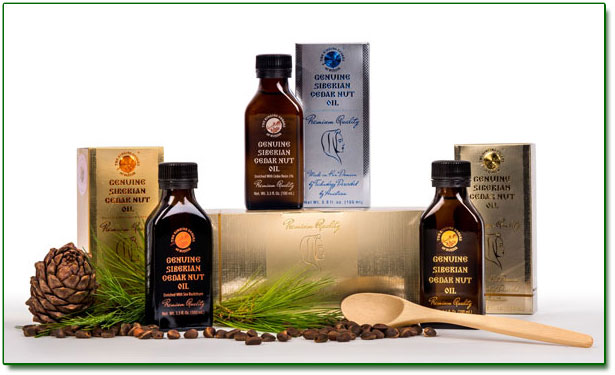
The nuts are used for the preparation of cedar nut oil. The oil contains twice as much vitamin E in comparison to walnuts and almonds, as well as vitamin P (essential fatty acids). In its total of fatty acids, cedar nut oil exceeds peanut oil, soy oil, sunflower oil, corn oil, and cotton-seed oil.
High quality cedar nut oil stimulates the immune system, increases a person's resistance to upper respiratory tract infections, bronchitis, and tuberculosis, especially in the less severe forms of the illness.
Cedar nuts and preparations based on them are considered to be the safest type of preparations, and even in large doses may cause perhaps only looseness of the stool.
Asthma is directly associated with the inflammation of the membranes and cells in the respiratory system. In view of the fact that cedar nut oil possesses marked anti-inflammatory properties, it is one of the best natural methods for improving the physical condition in cases of asthma.
The kernels of cedar nuts contain a large quantity of flavonoids - antioxidants (kaempferol, quercetin, myricetin, etc.) that provide the anti-inflammatory effect of cedar nut oil.
Since it is a natural vitamin-mineral complex, cedar nut oil acts as an active biological additive for persons suffering from asthma.
Cedar nut oil contains the following elements, which are essential in cases of asthma:
Quercetin. Research into quercetin, which has been carried out in a test tube, showed that it inhibits (slows) the release of the inflammatory substances from fat cells that participate in allergic reactions. Certain medications act to counter asthma in accordance with the same principle. Quercetin is a component of many biological additives for asthmatics.
Magnesium. Magnesium, present in cedar nut oil, participates in the processes of carbohydrate and phosphorus metabolism, possesses antispasmodic and vasodilator properties, which, in their turn, eliminate or prevent spasms of the vessels and asthma attacks.
An analysis of the blood taken from persons during an asthma attack often shows a deficit of magnesium.
Molybdenum. A deficiency of molybdenum very often occurs in people who have allergic sensitivity to sulfites (found in wine and eggs). Molybdenum is that substance that is essential to weaken the toxic effect of sulfites, and when experiencing a deficiency, a person becomes still more strongly subject to allergic sensitivity. If an asthmatic attack occurs in a person when consuming products with sulfites, cedar nut oil will assist in becoming more tolerant to these products.
Essential fatty acids. Essential fatty acids, which play an important role in the regulation of inflammatory prostaglandins in the body, may assist in lowering swelling and spasmodic hyperactivity of the bronchial tubes, especially in allergic asthma.
Vitamin B6. The level of vitamin B6 (pyridoxine) in asthmatics may be low, especially in persons who take bronchodilators based on theophylline.
In the opinion of some doctors, taking the vitamin assists in asthmatic shortness of breath, sometimes significantly.
Vitamin B12. On the basis of a large number of studies on persons of all ages, including infants, it has been shown that vitamin B12 is an excellent remedy for easing respiration in asthmatics. It is not precisely clear how the vitamin assists in relaxing the bronchial tubes, but it is very effective in increasing the ability to tolerate physical loads and allergens, that is, substances that cause allergic symptoms.
Vitamin E. Tocopherol (vitamin E) ensures that the cardiac muscle functions normally, and is effectively used in the treatment of diabetes and (since recently) asthma.
Lecithin. Lecithin is the basic substance that makes up a surfactant. A surfactant is a fluid that, in the form of a thin film, covers the inner surface of the alveoli, and ensures their stability during respiration, improves the flow of the bronchial secretions along the epithelium, and facilitates its removal. A baby's first breath, as all subsequent inhalations and exhalations, occurs precisely thanks to a surfactant. And it is precisely the surfactant that suffers in the respiratory processes.
As a food additive for the restoration of the surfactant, lecithin may be prescribed by physicians of various specializations in cases of illnesses of the respiratory tracts (bronchitis, asthma, tuberculosis, obstructive pulmonary disease).
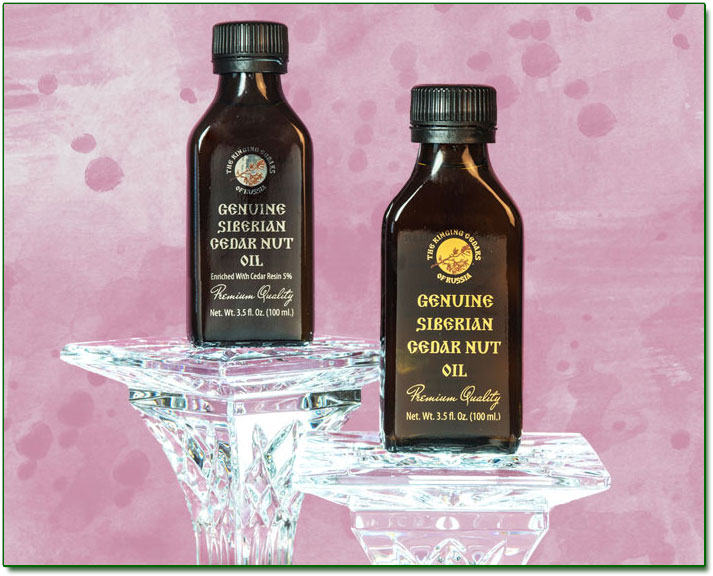
Taking into consideration that, in cases of asthma, many food products are excluded from the diet, the human body may not obtain enough essential elements for normal functioning.
Summing up the foregoing, cedar nuts and cedar nut oil, when at least 15 ml is taken per day (one teaspoon before eating), not only assist in maintaining the essential level of biologically active substances in the body, but also may significantly improve the general health of persons who suffer from bronchial asthma.
Anastasia V. Anikina, PhD.,
Research Institute of Therapy and Preventive Medicine
Novosibirsk
* * *
Customer Reviews:
I have been taking this for Eosinophilic Esophagitis. It seems to work well. I stopped having issues after I started taking it. This is a very strong and potent product. It is a first quality product.
Mauri Bowles, USA
* * *
I am a Doctor and can reccommend this oil AS an aide to Prilosec and all other acid inhibitors. Two or three teaspoon fulls thru the day(it is pleasant tasting and should be part of your intake.
Migdal, USA
* * *
This is a great product to heal leaky gut. It does taste like Christmas, but it is so beneficial to me and my health. My skin is more vibrant and I feel so good. Glad to see also that it has many uses.
Karen Takacs, USA
Buy this product for $35.80


CEDAR NUT AND OLIVE TAPENADE STUFFED DATES
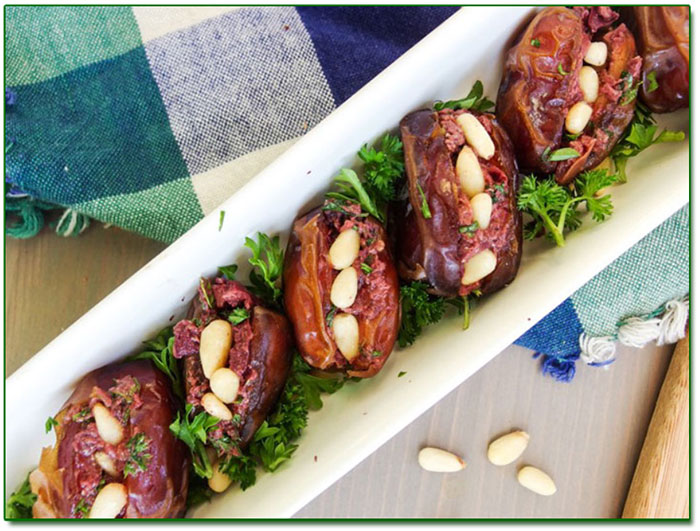
Toasted cedar nut and kalamata olive tapenade-stuffed dates. The perfect sweet, salty, crunchy bite for your vegan appetizer platter. Naturally gluten-free, grain-free, paleo recipe.
Ingredients:
For the kalamata olive tapenade:
- 1 clove garlic finely chopped
- 2 tsp shallot finely chopped (optional)
- 1/3 cup fresh curly parsley loosely-packed to measure, then finely chopped
- 1 tbsp nutritional yeast optional
- 2/3 cup pitted Kalamata olives
For the cedar nut and olive tapenade stuffed dates:
- 15 Medjool dates pitted
- olive tapenade (see above, or use your favorite recipe with parsley added)
- 3 tbsp toasted cedar nuts
Preparation:
For the kalamata olive tapenade:
1. Add the garlic, shallot, parsley, and nutritional yeast to a blender or food processor (I use my Magic Bullet). Pulse until the parsley is finely chopped.
2. Add the kalamata olives, and pulse just until the olives are broken up into small pieces - you don't want to puree them.
For the cedar nut and olive tapenade stuffed dates:
1. Stir the toasted cedar nuts into the olive tapenade.
2. Open each Medjool date and scoop in enough of the tapenade mixture to fill it completely.
CANTONESE-STYLE TOFU, CEDAR NUT, AND JICAMA LETTUCE CUPS
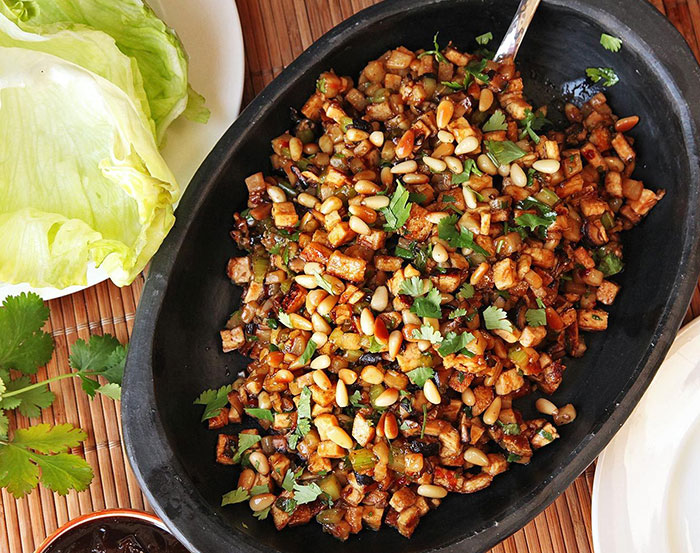
Ingredients:
- 1 (14-ounce; 400g) block firm tofu
- 1 tablespoon (15ml) Shaoxing wine or dry sherry
- 1 tablespoon (15ml) dark soy sauce
- 2 teaspoons (10ml) Chinese black vinegar or cider vinegar
- 4 tablespoons (60ml) hoisin sauce, plus more for serving
- 2 teaspoons (10ml) chili sauce, such as Sriracha or sambal oelek (optional)
- 1 teaspoon (about 3g) cornstarch
- 1 1/2 ounces cedar nuts (40g; about 1/4 cup)
- 1/4 cup (60ml) cedar nut oil, divided
- 2 1/2 ounces shiitake mushrooms, stems removed, cut into 1/4-inch dice (70g; about 1 cup diced)
- 3 scallions, white and pale green parts only, thinly sliced
- 3 medium cloves garlic, minced (about 1 tablespoon; 15ml)
- 1 (1-inch) knob ginger, minced (about 1 tablespoon; 15ml)
- 4 ounces jicama, peeled and cut into 1/4-inch dice (about 1/2 of an apple-sized jicama; 120g)
- 2 ounces celery, cut into 1/4-inch dice (about 1 large stalk; 60g)
- Handful chopped fresh cilantro leaves
- salt
- Ground white pepper
- 1 head iceberg or green leaf lettuce, picked into individual leaves, stored in ice water until ready to use
Preparation:
Cut tofu into 1/4-inch slabs. Press firmly between paper towels to remove excess moisture, then cut into 1/4-inch dice. Set aside.
Combine Shaoxing wine, soy sauce, vinegar, hoisin sauce, chili sauce (if using), cornstarch, and 1 tablespoon (15ml) water in a small bowl and mix with a fork until homogeneous. Set aside.
Combine cedar nuts and 1 tablespoon (15ml) oil in a wok and place over medium heat. Cook, stirring frequently, until nuts are well toasted, about 5 minutes. Transfer to a large bowl and set aside.
Add 1 tablespoon oil to wok and heat over high heat until lightly smoking. Add tofu and cook, stirring occasionally, until tofu is well browned all over, 6 to 8 minutes. Transfer to bowl with cedar nuts.
Add 1 tablespoon oil to wok and heat over high heat until lightly smoking. Add shiitakes and cook, stirring occasionally, until well browned all over, about 3 minutes. Transfer to bowl with tofu and cedar nuts.
Heat remaining tablespoon oil in wok over high heat until lightly smoking. Add scallions, garlic, and ginger and cook, stirring and tossing constantly, until fragrant, about 15 seconds. Add jicama and celery and toss to combine. Return tofu, mushrooms, and cedar nuts to wok and toss to combine. Stir sauce with a fork to reintegrate any cornstarch that may have settled to the bottom, then add to wok. Cook, tossing and stirring constantly, until all vegetables are evenly coated in sauce. Stir in cilantro (reserve a little for garnish) and season to taste with salt and white pepper. Transfer to a warm serving platter and sprinkle with reserved cilantro.
Serve immediately. To eat, spread a little hoisin sauce on the bottom of a lettuce leaf and spoon the filling into the lettuce. Eat with your hands.
ROASTED PEPPER SLAD WITH FETA, CEDAR NUTS AND BASIL
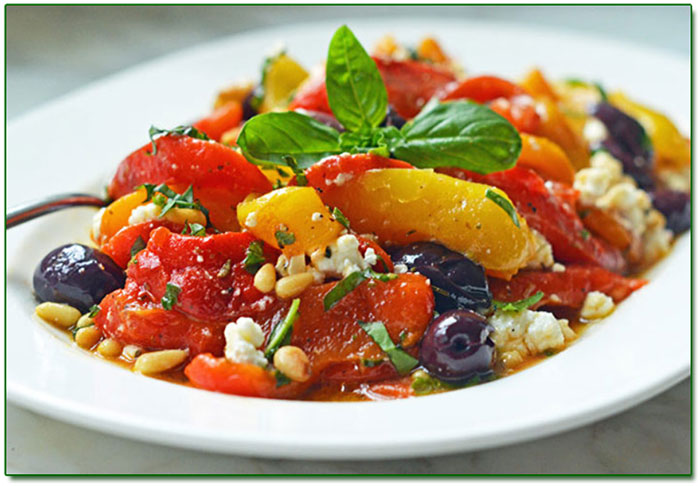
Next time you’re asked to bring a veggie or salad to a summer party, try these sweet and smoky bell peppers topped with tangy feta, toasted cedar nuts, fresh basil and olives.
Ingredients:
- 4 bell peppers (any combination of red, yellow or orange), halved, seeded and cored
- 2 tablespoons cedar nut oil
- 2 teaspoons red wine vinegar
- 1 small garlic clove, minced
- 3 tablespoons chopped fresh basil, divided
- 1/2 teaspoon dried oregano
- 1 teaspoon sugar
- 3/4 teaspoon salt
- 1/8 teaspoon freshly ground black pepper
- 3 tablespoons cedar nuts
- 2 ounces (a scant 1/2 cup) crumbled Feta
- 1/3 cup pitted kalamata olives
Preparation:
Set an oven rack in the top position and preheat the broiler. Line a baking sheet with aluminum foil. Place the pepper halves on the prepared baking sheet and broil for 5-10 minutes, rotating the pan once, until well charred. Remove the peppers from the oven and place in a bowl; cover tightly with plastic wrap (so they steam) and let cool until luke warm.
Peel the skin from the peppers (do not rinse under water) and cut into 3/4-inch strips. Place back in the bowl; add the cedar nut oil, red wine vinegar, garlic, 2 tablespoons of the basil, oregano, sugar, salt and pepper. Refrigerate for at least one hour or overnight.
Transfer the marinated peppers to a serving dish and top with the feta, olives, toasted cedar nuts and remaining tablespoon basil (do not toss). Garnish with whole basil leaves if desired.
Servings: 4
https://yupitsvegan.com/; https://www.seriouseats.com/; https://www.onceuponachef.com/
CEDAR NUTS CAN BE SUBSTITUTED WITH CEDAR NUT FLAKES.
For more recipes please click here

For Educational purposes only
This information has not been evaluated by the Food and Drug Administration.
This information is not intended to diagnose, treat, cure, or prevent any disease.
These articles come directly from researchers and are passed on to everybody. The company assumes no liability for any content in these articles.
For more great articles go to http://www.ringingcedarsofrussia.org/cedar_nuts_and_ringing_cedars_information.php